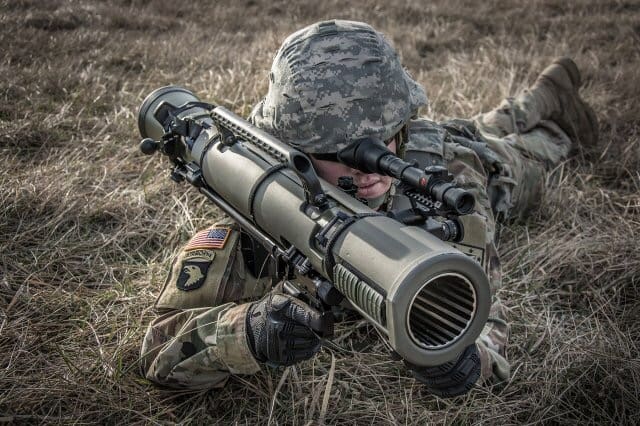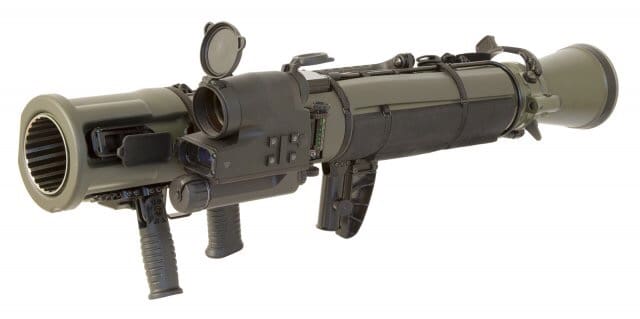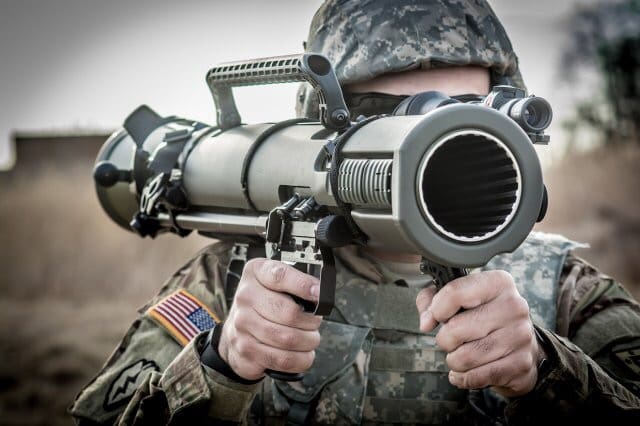ABERDEEN PROVING GROUND, Md. — Used on battlefields around the world since 1991, the M3 Multi-Role Anti-Armor Anti-Personnel Weapon System, or MAAWS, has seen several iterations.
The latest version, or M3E1, is not only lighter, but shorter and ergonomically designed with a longer handle and better grips. These features, as well as its ability to use multiple types of rounds for firing, has led the Army to approve a requirement for 1,111 M3E1 units.
“The current system that the Army uses is the AT4, which only allows Soldiers to fire one shot, and then they have to throw the system away. With the M3E1, Soldiers can use different types of ammunition which gives them an increased capability on the battlefield,” said Randy Everett, Foreign Comparative Testing, or FCT, project manager.
The M3E1 is part of the Product Manager Crew Served Weapons portfolio, which is processing a contract to procure 1,111 M3E1s and an Urgent Material Release to field them as soon as possible.
The U.S. Army FCT program office, which is positioned within U.S. Army Research, Development and Engineering Command, receives oversight from the Office of the Secretary of Defense’s Comparative Technology Office. The FCT program provides an avenue for Army engineers, scientists and program managers to test and evaluate items and technologies from allies and other friendly nations that may fill an Army capability gap.
The program encourages international cooperation and helps reduce the DOD’s overall acquisition costs by providing funds to formally test and evaluate foreign non-developmental items, commercial-off-the-shelf items, or technologies which are in the late state of development that may satisfy U.S. military requirements.
In 1988, U.S. Special Forces identified a need for a shoulder-fired, recoilless rifle to replace the M67, and Saab Dynamics developed the M3, which was a likely candidate to address the need. It was through the FCT program that the first M3s were delivered to U.S. Rangers and U.S. Navy Seals in 1994.
Kevin Finch, MAAWS product director, has worked on the M3 program throughout the years, collaborating with Saab Dynamics AB, the Swedish vendor, to perfect their system.
According to Soldier feedback, the M3 was too heavy and bulky. By using titanium, the updated M3E1 is more than six pounds lighter. The M3E1 is also 2.5 inches shorter and has an improved carrying handle, extra shoulder padding and an improved sighting system that can be adjusted for better comfort without sacrificing performance.
In response to the new requirement, a wiring harness was included in the M3E1 configuration that provides a foregrip controller and programmable fuze setter for an interchangeable fire control system. For added safety and cost savings, an automatic round counter enables Soldiers and logisticians to accurately track the service life of each weapon.
The system was tested for gun tube safe service life at IMT Materialteknik AB in Sundsvall, Sweden by the U.S. Army Test & Evaluation Command and other subject matter experts. Testing at the vendor’s test facility in Sweden eliminated the need to purchase ammunition and material, and it limited range time in the U.S., saving the Army nearly one million dollars.
The M3E1 uses the same family of ammunition as the M3, which has already been successfully tested.
As a result of this project, the Army received the OSD award for the FCT program. Click here to read the article.
“Our original investment of $3 million has led to an approximate $40 million procurement for the Army, which is a great return on investment. But, most importantly, the M3E1 can be reused so it gives Soldiers increased flexibility and capability on the battlefield,” Everett said.
For more information on the FCT program, visit cto.acqcenter.com.





I guess the benefit of being reused on the battlefield relates to being able to have a system that can use a variety of warheads for a multitude of different targets. I have seen and heard lots of comments about the Carl Gustaf’s benefits for hitting a larger target set. I have not heard of the logistic footprint of carrying the rounds. Has anyone had any experience with it, or have the info? As for the FACT program, even though it is not an original US weapon system, it is a system that has been fitting the need, has been successful, and has not been upgraded in conjunction with Sweden. This saves time, resources, and.money. it’s great to see the military get such a great weapon system, and to get it upgraded based on direct feedback from the end users. Thank you to all involved.
I don’t know what grenades the US uses, but FFV 551 (HEAT) and FFV 441 (HE, can air burst) come in holders with 2 grenades for 8kg total. In Norway a typical 8 man CG squad carries 2 tubes and 8 grenades per tube. It’s possible to strap 6-8 grenades to a guys pack/frame, but it becomes a weight and volume issue after that.
IIRC, this is the new Carl-Gustaf M4 produced by Saab so Sweden is definitely involved in this upgrade
http://saab.com/land/weapon-systems/support-weapons/carl-gustaf-m4/
Sorry for the mistype. Meant “has been upgraded in conjunction with Sweden”.
The Army screws up a lot of things but this seems legit. Maybe the Corps will decide to ditch the SMAW. That thing is just terrible.
Supposedly, that’s the plan but they have a large stockpile of rounds they have to deal with.
Any word on those Salt-Water rounds that alleviate blast pressure enabling ability to fire more shots with less stress on the user?
Thanks, I was curious. The original was good, and this seems better, but capability needs to take a back seat to long-term health and welfare. Blowing out knees is one thing, but brain damage is a bridge too far.
Unless you’re firing inside of a concrete bunker you’ll be fine. And they are developing rounds that can be fired from inside structures.
I’ve been range safety between 2 tubes for more than 50 rounds a day. Sure, you’re kinda beat after that, but consider what a combat load is- and you realize it’s not a problem.
If it’s fielded in a manner consistent with what I saw for Rocket/Missile systems while I was in (having been issued a AT4 in Iraq, and for a short period being a Javelin gunner), should we assume these will just be given to the new guy, and nothing more than a “this is the trigger” training session will occur?
Why on earth would we want to change how we do these things, and actually worry about thoroughly training the gunners to some level of actual real-world proficiency?
The US Army has a long history of waiting to do this kind of training “on the job” during the opening phases of every conflict. Why change?
Yes, I’m a cynic about this kind of thing. But, then, I’m the guy who used to take care of a small herd of M67 90mm Recoilless Rifles, and over all the years I did that, I only got to see that sumbitch fired but about twice. The rest of the time? The weapons were big, awkward training aids that got broken more by people treating them like unwanted sewer pipes they’d been saddled with than the really useful weapons that they were.
I’m not a fan of the Army’s weapons training and policies for such. More than likely, there’s gonna be one decent New Equipment Training session performed with these things, and then it’s all gonna be “training by expectation of osmosis” by the commanders, and they’re gonna be all confused-like when they go to war and nobody is using the goddamn Carl Gustav in any effective way. When you go back to do a forensic examination of why it all went to shit, what they’re gonna find is that of the 15 guys in every company that were on the roster for the New Equipment Training, 5 were short-timers in the unit, 8 were immediately reassigned to new jobs, and the three dudes who wound up staying on the weapon were the three biggest dumbasses in the company, who very nearly failed to qualify with it. And, of those three? In five years, one of them will be a senior squad leader or platoon sergeant who thinks they know everything about the Carl Gustav, and will have ignored two or three major changes to the TM and the employment techniques laid out in the latest FM. They’ll still be passing on all their “expertise” that’s ten or more years out of date when they retire as Command Sergeant Majors…